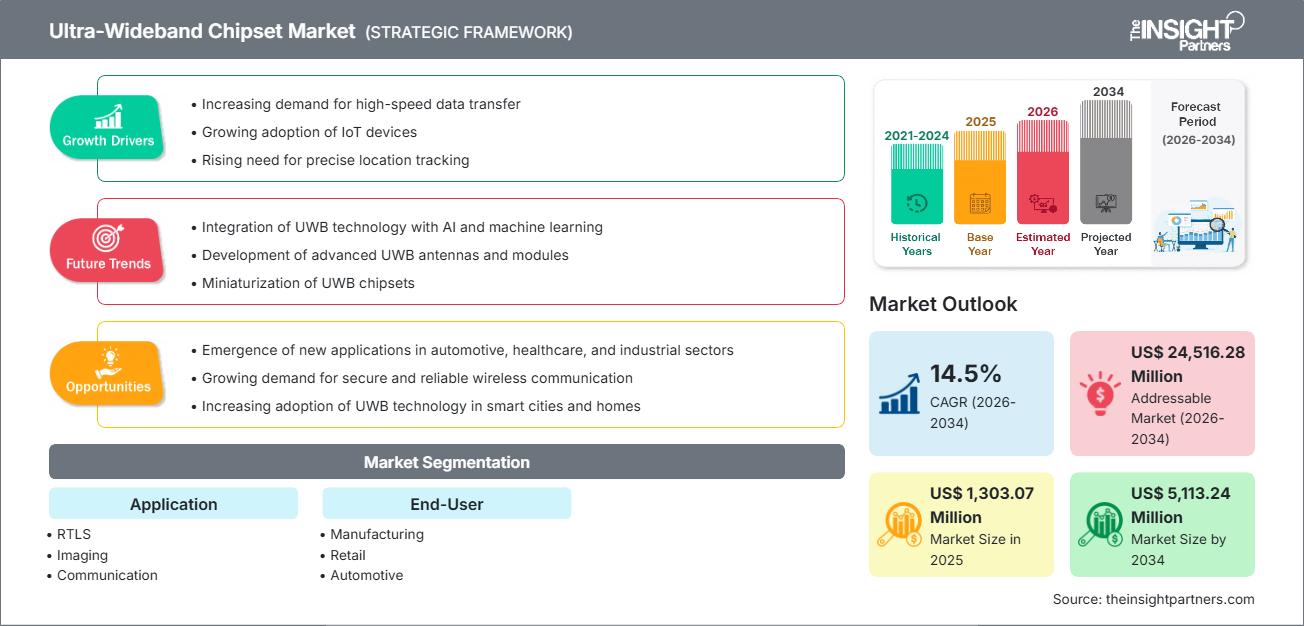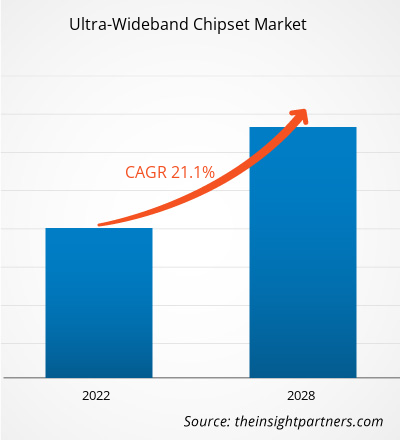El tamaño del mercado de chipsets de banda ultra ancha se valoró en US$1.303,07 millones en 2025 y se espera que alcance los US$5.113,24 millones en 2034, creciendo a una CAGR del 14,5 % entre 2026 y 2034.
Análisis del mercado de chipsets de banda ultraancha
Se prevé que el mercado de chipsets de banda ultra ancha (UWB) crezca fuertemente, debido a la creciente adopción de la tecnología UWB en sistemas de ubicación en tiempo real (RTLS), la demanda de seguimiento de activos de alta precisión y la integración de UWB en dispositivos industriales y de consumo.
La tecnología UWB ofrece mayor precisión, mayor ancho de banda, menor consumo de energía y mejor resistencia a interferencias en comparación con los enfoques RTLS tradicionales (por ejemplo, RFID, posicionamiento basado en Wi-Fi), lo que la hace atractiva para aplicaciones que requieren un posicionamiento preciso en interiores y exteriores y una comunicación segura.
Además, el crecimiento de la IoT, los dispositivos inteligentes, la electrónica portátil, las aplicaciones automotrices (por ejemplo, acceso seguro, localización de vehículos) y la automatización industrial, todos los cuales se benefician de los chipsets UWB, está impulsando la demanda.
Descripción general del mercado de chipsets de banda ultraancha
Los chipsets de banda ultraancha son circuitos integrados que permiten la comunicación UWB, una tecnología inalámbrica que utiliza un amplio espectro de frecuencias para la transmisión y medición de distancias de datos de corto alcance, alta precisión y bajo consumo. Estos chipsets son fundamentales para habilitar sistemas de localización en tiempo real (RTLS) precisos, control de acceso seguro, comunicación entre dispositivos y otros usos en los sectores de la electrónica de consumo, la automoción, la industria, la salud y el comercio minorista.
Al permitir una precisión de localización a nivel de centímetros, baja latencia, resistencia a interferencias y comunicaciones energéticamente eficientes, los chipsets UWB ayudan a los fabricantes de dispositivos e integradores de sistemas a ofrecer un rendimiento sólido, ya sea para rastrear activos en un almacén, habilitar la conciencia espacial de los teléfonos inteligentes o proporcionar una entrada segura sin llave en automóviles.
A medida que la demanda de posicionamiento preciso, seguimiento en tiempo real y comunicación segura continúa aumentando, los conjuntos de chips UWB están surgiendo como un componente de infraestructura crítica en Múltiples verticales.
Personalice este informe según sus necesidades
Recibirá personalización de cualquier informe, sin cargo, incluidas partes de este informe o análisis a nivel de país, paquete de datos de Excel, y además aprovechará grandes ofertas y descuentos para empresas emergentes y universidades.
Mercado de chipsets de banda ultraancha: Perspectivas estratégicas

-
Obtenga las principales tendencias clave del mercado de este informe.Esta muestra GRATUITA incluye análisis de datos, desde tendencias del mercado hasta estimaciones y pronósticos.
Impulsores y oportunidades del mercado de chipsets de banda ultraancha
Factores impulsores del mercado:
- Necesidades de localización y seguimiento de alta precisión: la demanda de sistemas de localización en tiempo real (RTLS) precisos en los sectores de fabricación, logística, comercio minorista, atención médica e infraestructura inteligente está aumentando, lo que impulsa la adopción de UWB en lugar de alternativas menos necesarias.
- Creciente integración en dispositivos electrónicos de consumo y inteligentes: a medida que proliferan los teléfonos inteligentes, los wearables, los dispositivos domésticos inteligentes y los gadgets de IoT, los chipsets UWB se incorporan cada vez más para permitir la conciencia espacial, la comunicación segura y las funciones basadas en la proximidad.
- Aplicaciones automotrices en aumento: la tecnología UWB se está aprovechando para el ingreso seguro al automóvil, la localización y las funciones de comunicación, lo que contribuye a una mayor demanda de conjuntos de chips por parte de los fabricantes de automóviles.
- Demanda de comunicaciones de bajo consumo y resistentes a interferencias: las ventajas inherentes de UWB, baja latencia, robustez contra trayectos múltiples/interferencias y eficiencia energética, lo hacen adecuado para sistemas inalámbricos modernos que necesitan confiabilidad y precisión.
Oportunidades de mercado:
- Expansión a través de industrias y casos de uso de tecnología emergente: con la creciente demanda en logística, fabricación inteligente, seguimiento de activos de atención médica, gestión de inventario minorista y automatización de hogares y oficinas inteligentes, se espera que la adopción de chipsets UWB se amplíe.
- Proliferación de IoT y dispositivos inteligentes: a medida que los ecosistemas de IoT se expanden globalmente, la incorporación de chipsets UWB en más dispositivos ofrece un potencial de crecimiento considerable, incluso en wearables, etiquetas inteligentes y comunicación de dispositivo a dispositivo.
- Innovaciones en automoción y movilidad: el uso de UWB en el acceso a vehículos, la comunicación segura y la localización sugiere importantes oportunidades para los proveedores de chipsets que se asocian con fabricantes de equipos originales (OEM) de automóviles.
- Migración de tecnologías de seguimiento y comunicación tradicionales: a medida que las empresas y los consumidores exigen mayor precisión y seguridad, UWB se presenta como un reemplazo para los sistemas más antiguos (por ejemplo, RFID, Bluetooth básico), lo que impulsa la adopción de chipsets.
Análisis de la segmentación del mercado de chipsets de banda ultraancha
Por aplicación:
- Sistemas de localización en tiempo real (RTLS)
- Imágenes
- Comunicación
Por usuario final/industria vertical:
- Fabricación
- Minorista
- Automotor
- Cuidado de la salud
- Electrónica de consumo
Por geografía:
- América del norte
- Europa
- Asia Pacífico
- América del Sur y Central
- Oriente Medio y África
Perspectivas regionales del mercado de chipsets de banda ultraancha
Los analistas de The Insight Partners han explicado detalladamente las tendencias y los factores regionales que influyen en el mercado de chipsets de banda ultraancha durante el período de pronóstico. Esta sección también analiza los segmentos y la geografía del mercado de chipsets de banda ultraancha en Norteamérica, Europa, Asia Pacífico, Oriente Medio y África, y Sudamérica y Centroamérica.
Alcance del informe de mercado de chipsets de banda ultraancha
| Atributo del informe | Detalles |
|---|---|
| Tamaño del mercado en 2025 | US$ 1.303,07 millones |
| Tamaño del mercado en 2034 | US$ 5.113,24 millones |
| CAGR global (2026-2034) | 14,5% |
| Datos históricos | 2021-2024 |
| Período de pronóstico | 2026-2034 |
| Segmentos cubiertos |
Por aplicación
|
| Regiones y países cubiertos |
América del norte
|
| Líderes del mercado y perfiles de empresas clave |
|
Densidad de actores del mercado de chipsets de banda ultraancha: comprensión de su impacto en la dinámica empresarial
El mercado de chipsets de banda ultraancha está creciendo rápidamente, impulsado por la creciente demanda de los usuarios finales debido a factores como la evolución de las preferencias de los consumidores, los avances tecnológicos y un mayor conocimiento de las ventajas del producto. A medida que aumenta la demanda, las empresas amplían su oferta, innovan para satisfacer las necesidades de los consumidores y aprovechan las tendencias emergentes, lo que impulsa aún más el crecimiento del mercado.

- Obtenga una descripción general de los principales actores clave del mercado de chipsets de banda ultraancha
Análisis de la cuota de mercado de chipsets de banda ultraancha por geografía
Según el informe de The Insight Partners, en 2021, la presencia regional del mercado abarcó América del Norte, Europa, Asia-Pacífico, América Latina, Oriente Medio y África.
Históricamente, Asia-Pacífico ha tenido una participación sustancial en los ingresos (liderando entre las regiones), seguida por América del Norte y Europa.
Se espera que el crecimiento entre regiones varíe dependiendo de las tasas de adopción de tecnología, la industrialización, la penetración de la electrónica de consumo, la integración automotriz y el desarrollo de la infraestructura de IoT, ofreciendo un potencial particular en Asia-Pacífico y las economías emergentes.
Panorama competitivo y densidad de jugadores
La presencia de múltiples actores globales y desarrolladores de chipsets especializados caracteriza el mercado de chipsets de banda ultraancha. Estos proveedores se diferencian por:
- Integración de chipsets UWB en circuitos integrados versátiles para dispositivos de consumo e IoT.
- Diseño avanzado de chipset que optimiza la potencia, el ancho de banda y la resistencia a las interferencias.
- Colaboraciones estratégicas con fabricantes de dispositivos (teléfonos inteligentes, OEM automotrices, fabricantes de equipos industriales) para integrar UWB en productos de próxima generación.
- Innovación orientada a adaptar UWB para aplicaciones RTLS, de comunicación e imágenes en diversos sectores verticales.
Principales empresas que operan en el mercado de chipsets de banda ultraancha
- ALEREON, Inc.
- Apple Inc.
- Bespoon SAS
- Decawave Limitada
- Compañía Taiyo Yuden, Ltd.
- Johanson Technology, Inc.
- NOVELDA AS
- NXP Semiconductors NV
- Pulse-Link, Inc.
Otros actores analizados durante el curso de la investigación son:
- Texas Instruments Incorporated
- STMicroelectronics NV
- Samsung Electronics Co., Ltd.
- Corporación Zebra Technologies
- Corporación Sony
- Infineon Technologies AG
- Compañía de fabricación Murata, Ltd.
- Corporación LitePoint
- Sewio Networks sro
- Nanotron Technologies GmbH
Noticias y desarrollos recientes del mercado de chipsets de banda ultraancha
- El informe global de The Insight Partners reafirma un fuerte crecimiento, y se proyecta que el mercado de chipsets UWB alcance los US$1.906,46 millones para 2028.
- La creciente implementación de UWB en RTLS, dispositivos de consumo y sectores automotrices se identifica como un impulsor clave del crecimiento debido a la mayor precisión de UWB y su capacidad para reemplazar los sistemas de seguimiento/comunicación tradicionales.
Informe de mercado sobre chipsets de banda ultraancha: cobertura y resultados
El informe "Tamaño y pronóstico del mercado de chipsets de banda ultraancha (2021-2034)" de The Insight Partners ofrece:
- Tamaño detallado del mercado y pronósticos a nivel global, regional y nacional para segmentos clave.
- Análisis de las tendencias del mercado, los impulsores del crecimiento, las oportunidades y la dinámica subyacente del mercado.
- Segmentación por aplicación, usuario final y geografía.
- Panorama competitivo y perfiles de empresas líderes en proveedores de chipsets.
- Análisis histórico (2 años), año base, pronóstico (7 años) con CAGR
- Análisis PEST y FODA
- Tamaño del mercado, valor/volumen: global, regional y nacional
- Industria y panorama competitivo
- Conjunto de datos de Excel
Informes recientes
Testimonios
Razón para comprar
- Toma de decisiones informada
- Comprensión de la dinámica del mercado
- Análisis competitivo
- Información sobre clientes
- Pronósticos del mercado
- Mitigación de riesgos
- Planificación estratégica
- Justificación de la inversión
- Identificación de mercados emergentes
- Mejora de las estrategias de marketing
- Impulso de la eficiencia operativa
- Alineación con las tendencias regulatorias






















 Obtenga una muestra gratuita para - Mercado de chipsets de banda ultraancha
Obtenga una muestra gratuita para - Mercado de chipsets de banda ultraancha